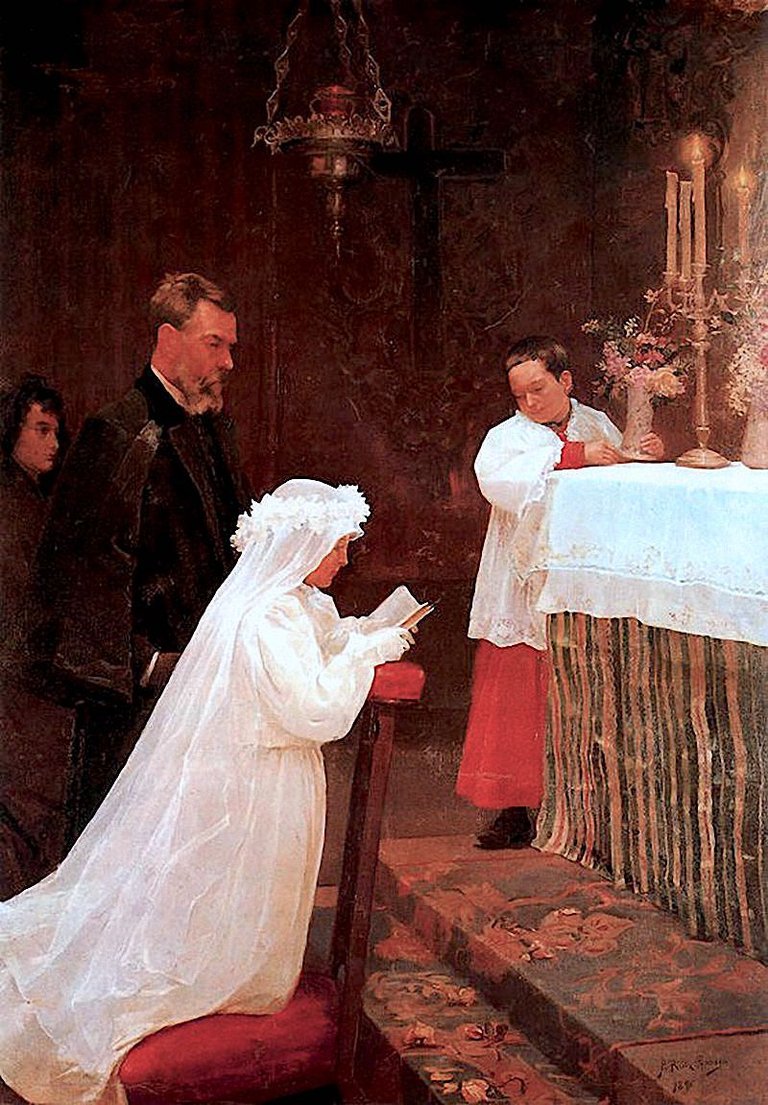
Hello everyone in the CELF Magazine community! Today I join the community to talk about Cubism, a particular style that leaves many with a lot to say. The painting that I leave here above is titled The First Communion (1896) and believe it or not, it is by the painter Pablo Picasso, but why did Picasso manage to paint scenes like these in such an agile way and end up with such a different pictorial style? Here I tell you everything about it. Let's get started.
Cubism emerged as a deconstruction of the figure. That is to say, what we see in the painting in the publication is a figurative painting (realistic style) because we all understand the characters that appear on the scene (the girl, the priest, the altar boy, the woman in the back and even the objects and place. where they are present). Now, when we talk about Cubism we are going to take any figure that appears in that painting (for example, the girl) and we are going to take it to its state of greatest simplicity, that is, before being an anatomically perfect character, that girl was a drawing composed of circles, ovals, lines and many geometric figures. She added color to all those geometric figures (the painting technique) and we have the Cubist style.
¡Hola a todos en la comunidad de CELF Magazine! El día de hoy me uno a la comunidad para hablar sobre el Cubismo, un estilo particular que deja a muchos con mucho que decir. La pintura que dejo acá arriba se titula La Primera Comunión (1896) y aunque no lo crean, es del pintor Pablo Picasso, pero ¿por qué sí Picasso lograba pintar de forma tan ágil escenas como estas terminó con un estilo pictórico tan diferente? Aquí les cuento todo sobre ello. Comencemos.
El cubismo surgió cómo una deconstrucción de la figura. Es decir, lo que vemos en la pintura de la publicación es una pintura figurativa (de estilo realista) porque todos entendemos los personajes que aparecen en escena (la niña, el cura, el monaguillo, la mujer de atrás y hasta los objetos y lugar dónde están presentes). Ahora, cuando hablamos de Cubismo vamos a tomar cualquier figura que aparece en ese cuadro (por ejemplo, la niña) y lo vamos a llevar a su estado de mayor simplicidad, es decir, antes de ser un personaje anatómicamente perfecto, esa niña fue un dibujo compuesto por círculos, óvalos, rectas y muchas figuras geometricas. Le añadieron color a todas esas figuras geometricas (la técnica pictórica) y tenemos el estilo Cubista.

That style was not created by Picasso alone, it was together with George Braque (another painter), who at the time (1904) used the collage technique (mixed technique where scraps of paper and paint are used) and used tones that were " grey" (ocher, blue, etc.). It was their study of the elements arranged on a plane. Then they added more shades with more and more striking colors. And because it was very difficult to know what figure was seen in those paintings, they added names to identify what was portrayed (Harlequin with Guitar, Still Life and Guitar, the Card Player, etc.). This way it was much easier for people to visualize what was stated in that box. Juan Gris was also an exponent.
It is likely that the bad reputation of Cubism is due to the fact that it was highly criticized in its time (and still), since in addition the person who gave it the name Cubism was the art critic Louis Vauxcelles who considered it to be a terrible style and gave it that name in a derogatory way. The importance of Cubism (what makes it so great) is that it was one of the first movements that approached Abstraction, a style that further simplified the elements within a painting. Here it is not about whether it is beautiful/ugly, good/bad, pleasant/unpleasant and so on, it is a question about a search for identity that every artist desires and that also opened up new styles with the study of shapes, color, the composition and... The concept, something that we will see in many modern artistic trends. Form and content. Well, from now on, the form took a backseat and the content took priority. That is its real value in history.
Ese estilo no fue creado solo por hizo Picasso, fue junto con George Braque (otro pintor), quienes en su momento (1904) utilizaban la técnica del collage (técnica mixta dónde se usan retazos de papel y pintura) y usaban tonos que eran "grises" (ocres, azules, etc.). Era un estudio de ellos sobre los elementos dispuestos en un plano. Luego fueron añadiendo más tonalidades con colores más y más llamativos. Y debido a qué era muy difícil saber que figura se veían en esos cuadros, le añadieron nombres que identificaran lo retratado (Arlequín con Guitarra, Naturaleza Muerta y Guitarra, el Jugador de Cartas, etc.). Así era mucho más fácil para las personas visualizar lo planteado en ese cuadro. Juan Gris también fue un exponente.
Es probable que la mala fama del Cubismo se deba a que fue muy criticado en su tiempo (y todavía), pues además quién le dió ese nombre de Cubismo fue el crítico de arte Louis Vauxcelles quién considero que era un estilo terrible y otorgó ese nombre de forma despectiva. La importancia que tiene el Cubismo (lo que lo hace tan grande) es que fue uno de los primeros movimientos que se acercaron a la Abstracción, un estilo que simplificó aún más los elementos dentro de un cuadro. Aquí no se trata sobre si es bello/feo, bueno/malo, agradable/desagradable y demás, es una cuestión sobre una búsqueda de identidad que todo artista desea y que además dió apertura a nuevos estilos con el estudio sobre las formas, el color, la composición y... El concepto, algo que veremos en muchas tendencias artísticas modernas. Forma y contenido. Pues de ahora en más, la forma paso a segundo plano y el contenido cogió prioridad. He allí su valor real en la historia.

In any case, if Picasso was not an exceptional painter (capable of painting realistic paintings) and was not studied by the greats (such as Cézanne, his greatest exponent and with whom he was also able to find the "formula" to create Cubism), he was not able to understand "doing to undo." Well, clearly you cannot create something from nothing if you do not know, understand and know how to do something beforehand. Finally, I hope I have made myself understood and that my publication is helpful because I also asked myself at the time why Picasso. Without further ado, a hug.
De todas formas, si Picasso no fuera sido un pintor excepcional (capaz de pintar cuadros realistas) y no fuera estudiado a los grandes (cómo Cézanne, su mayor exponente y con el que también pudo dar con la "fórmula" para crear el Cubismo), el no fuera sido capaz de comprender "el hacer para el deshacer". Pues claramente no se puede crear algo de la nada si no se conoce, se entiende y se sabe hacer algo con anterioridad. Finalmente, espero haberme hecho entender y que mí publicación sea de ayuda pues yo también me pregunte en su momento el porqué de Picasso. Sin más que decir, un abrazo.

!discovery 35
This post was shared and voted inside the discord by the curators team of discovery-it
Join our Community and follow our Curation Trail
Discovery-it is also a Witness, vote for us here
Delegate to us for passive income. Check our 80% fee-back Program